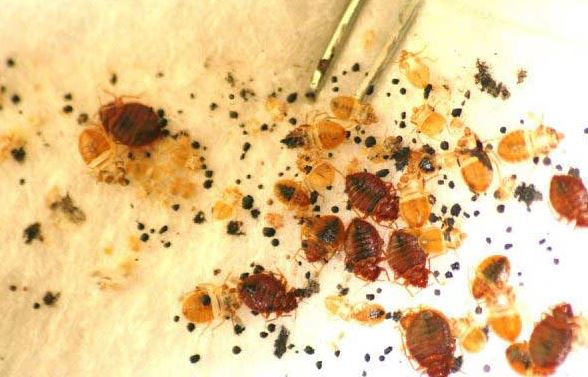Have you ever woken up with itchy bites and wondered if those tiny, blood-sucking creatures called bed bugs are lurking in your home? It’s a common fear, especially when you consider how easily these pests can infest even the cleanest of environments. One question that often arises is: Can bed bugs live on wood floors? The answer, unfortunately, is more complex than a simple yes or no.

Image: www.pinterest.com
Bed bugs are highly adaptable insects that have evolved to survive in a variety of environments, including your home. While they prefer soft, warm surfaces like mattresses and bedding, they can also survive on wood floors, especially if there are cracks, crevices, or gaps that offer them shelter.
The Science Behind Bed Bug Habitats
Understanding Bed Bug Biology
To understand why bed bugs might choose a wood floor as their home, we need to dive into their basic biology. Bed bugs are small, wingless insects that feed exclusively on blood. They rely on a host to survive, and that host is typically a human. Though they don’t spread diseases, they can cause severe itching and discomfort, leading to sleep disruptions and potential secondary infections from scratching.
Bed Bug Preferences: More Than Just Beds
While the name “bed bugs” suggests that their preferred habitat is your bed, their reality is more complex. These pests can thrive in diverse environments, including:
- Mattresses and Bedding: This is their primary habitat, offering access to their food source – humans.
- Baseboards and Moldings: They can hide in the cracks and crevices of these areas, especially if there are gaps or separations from the wall.
- Furniture and Upholstery: Sofas, chairs, and even curtains can provide a place for bed bugs to hide and thrive.
- Carpet and Rugs: These offer a soft, warm environment, particularly where they might be tucked under furniture.
- Floorboards and Cracks: While not their preferred habitat, they can still survive in these spaces, particularly if they have access to nearby shelters like furniture or beds.

Image: your-local-pest-control.com
Wood Floors and Bed Bugs: A Closer Look
The likelihood of bed bugs living on wood floors is often tied to factors such as:
- Floor Condition: Floors with cracks, gaps, or loose floorboards offer better hiding spots for bed bugs.
- Proximity to Beds: They are more likely to be present on floors near beds, especially those that are not regularly cleaned.
- Presence of Clutter: Clutter on the floor (like boxes, magazines, or clothes) can provide a pathway for bed bugs to reach the bed without being exposed.
- Type of Wood: While bed bugs don’t discriminate based on wood type, they might prefer areas with softer wood that can more easily be burrowed into.
- Maintenance: Regular vacuuming and cleaning can minimize the presence of bed bugs, even on wood floors.
Signs of Bed Bugs on Wood Floors
While you might not always see the bed bugs themselves, these signs can indicate their presence on wood floors:
<ul>
<li><strong>Dark, Rusty-Brown Stains:</strong> These are often droppings left behind by bed bugs, appearing small and scattered.
<li><strong>Shedding Skins:</strong> As bed bugs grow, they shed their skin, which can be seen as small, translucent flakes.
<li><strong>Eggs:</strong> Bed bug eggs are tiny, white, and pearlescent, typically found in clusters.
<li><strong>Musty Odor:</strong> A musty, sweet scent can indicate the presence of a large infestation.
</ul>Preventing Bed Bugs on Wood Floors
The best defense against bed bugs is to prevent them from entering your home in the first place. Here are some steps you can take:
<ul>
<li><strong>Regular Inspection:</strong> Check your beds, furniture, and floors for bed bugs and their signs, especially after traveling or bringing in used furniture.
<li><strong>Vacuum Regularly:</strong> Vacuum thoroughly, paying attention to corners, cracks, and crevices.
<li><strong>Maintain Cleanliness:</strong> Keep floors and furniture clutter-free, making it harder for bed bugs to hide.
<li><strong>Seal Cracks and Gaps:</strong> Caulk or repair any cracks or gaps in floors, walls, or baseboards to prevent entry.
<li><strong>Use Bed Bug-Proof Mattress Covers:</strong> Encase mattresses and box springs in covers that are specifically designed to prevent bed bug infestations.
<li><strong>Professional Inspection:</strong> If you suspect a bed bug infestation, contact a qualified pest control professional for inspection and treatment.
</ul>Can Bed Bugs Live On Wood Floors
Conclusion
While wood floors might not be the ideal habitat for bed bugs, they can certainly survive and even thrive on them, especially if the floors are not maintained properly. Understanding their biology and preferred environments is key to preventing bed bug infestations. Regular inspections, thorough cleaning, and prompt professional treatment are essential for keeping your home bed bug-free. Remember, vigilance and proactive measures are your best allies in the fight against these persistent pests.

:max_bytes(150000):strip_icc()/OrangeGloEverydayHardwoodFloorCleaner22oz-5a95a4dd04d1cf0037cbd59c.jpeg?w=740&resize=740,414&ssl=1)




